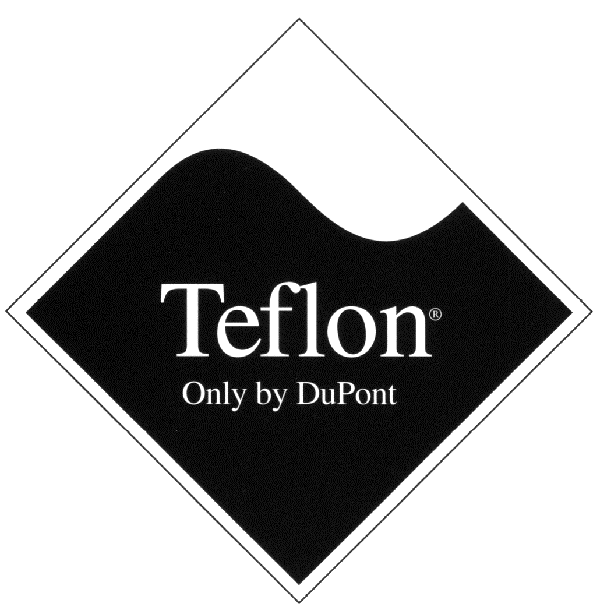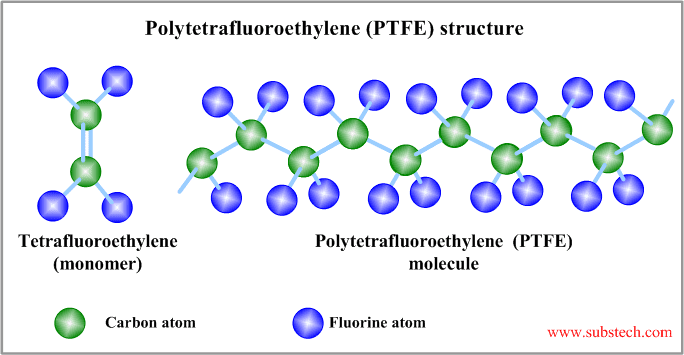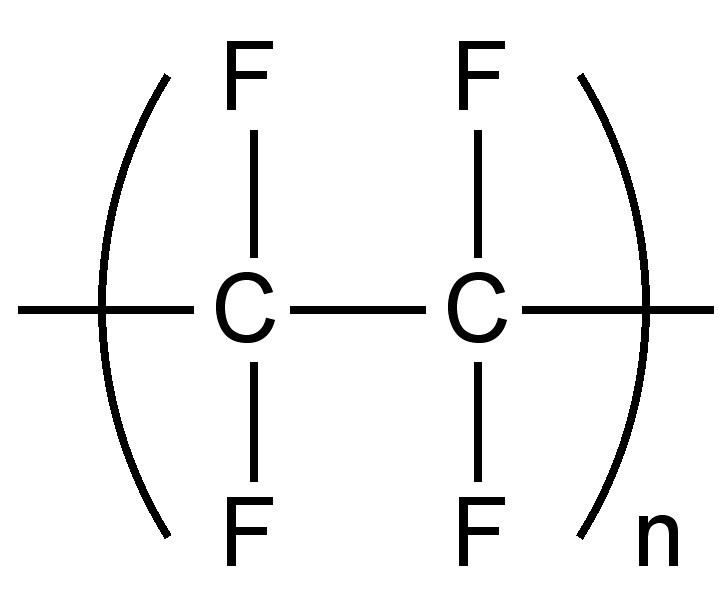Abbreviations PTFE Density 2.2 g/cm³ | Formula (C2F4)n Melting point 326.8 °C | |
 | ||
IUPAC ID poly(1,1,2,2-tetrafluoroethylene) | ||
Polytetrafluoroethylene (PTFE) is a synthetic fluoropolymer of tetrafluoroethylene that has numerous applications. The best known brand name of PTFE-based formulas is Teflon by Chemours. Chemours is a spin-off of DuPont Co., which discovered the compound in 1938.
Contents

PTFE is a fluorocarbon solid, as it is a high-molecular-weight compound consisting wholly of carbon and fluorine. PTFE is hydrophobic: neither water nor water-containing substances wet PTFE, as fluorocarbons demonstrate mitigated London dispersion forces due to the high electronegativity of fluorine. PTFE has one of the lowest coefficients of friction of any solid.

PTFE is used as a non-stick coating for pans and other cookware. It is very non-reactive, partly because of the strength of carbon–fluorine bonds, and so it is often used in containers and pipework for reactive and corrosive chemicals. Where used as a lubricant, PTFE reduces friction, wear and energy consumption of machinery. It is commonly used as a graft material in surgical interventions. Also, it is frequently employed as coating on catheters; this interferes with the ability of bacteria and other infectious agents to adhere to catheters and cause hospital-acquired infections.

History
PTFE was accidentally discovered in 1938 by Roy Plunkett while he was working in New Jersey for DuPont. As Plunkett attempted to make a new chlorofluorocarbon refrigerant, the tetrafluoroethylene gas in its pressure bottle stopped flowing before the bottle's weight had dropped to the point signaling "empty." Since Plunkett was measuring the amount of gas used by weighing the bottle, he became curious as to the source of the weight, and finally resorted to sawing the bottle apart. He found the bottle's interior coated with a waxy white material that was oddly slippery. Analysis showed that it was polymerized perfluoroethylene, with the iron from the inside of the container having acted as a catalyst at high pressure. Kinetic Chemicals patented the new fluorinated plastic (analogous to the already known polyethylene) in 1941, and registered the Teflon trademark in 1945.
By 1948, DuPont, which founded Kinetic Chemicals in partnership with General Motors, was producing over two million pounds (900 tons) of Teflon brand PTFE per year in Parkersburg, West Virginia. An early use was in the Manhattan Project as a material to coat valves and seals in the pipes holding highly reactive uranium hexafluoride at the vast K-25 uranium enrichment plant in Oak Ridge, Tennessee.
In 1954, the wife of French engineer Marc Grégoire urged him to try the material he had been using on fishing tackle on her cooking pans. He subsequently created the first Teflon-coated, non-stick pans under the brandname Tefal (combining "Tef" from "Teflon" and "al" from aluminum). In the United States, Marion A. Trozzolo, who had been using the substance on scientific utensils, marketed the first US-made Teflon-coated pan, "The Happy Pan", in 1961.
However, Tefal was not the only company to utilize PTFE in nonstick cookware coatings. In subsequent years, many cookware manufacturers developed proprietary PTFE-based formulas, including Swiss Diamond International, which uses a diamond-reinforced PTFE formula; Scanpan, which uses a titanium-reinforced PTFE formula; and both All-Clad and Newell Rubbermaid's Calphalon, which use a non-reinforced PTFE-based nonstick. Other cookware companies, such as Meyer Corporation's Anolon, use Teflon nonstick coatings purchased from DuPont.
In the 1990s, it was found that PTFE could be radiation cross-linked above its melting point in an oxygen-free environment. Electron beam processing is one example of radiation processing. Cross-linked PTFE has improved high-temperature mechanical properties and radiation stability. This was significant because, for many years, irradiation at ambient conditions has been used to break down PTFE for recycling. This radiation-induced chain scission allows it to be more easily reground and reused.
Production
PTFE is produced by free-radical polymerization of tetrafluoroethylene. The net equation is
n F2C=CF2 → −(F2C−CF2)n−Because tetrafluoroethylene can explosively decompose to tetrafluoromethane and carbon, special apparatus is required for the polymerization to prevent hot spots that might initiate this dangerous side reaction. The process is typically initiated with persulfate, which homolyzes to generate sulfate radicals:
[O3SO−OSO3]2− ⇌ 2 SO4•−The resulting polymer is terminated with sulfate ester groups, which can be hydrolyzed to give OH end-groups.
Because PTFE is poorly soluble in almost all solvents, the polymerization is conducted as an emulsion in water. This process gives a suspension of polymer particles. Alternatively, the polymerization is conducted using a surfactant such as PFOS.
Properties
PTFE is a thermoplastic polymer, which is a white solid at room temperature, with a density of about 2200 kg/m3. According to DuPont, its melting point is 600 K (327 °C; 620 °F). It maintains high strength, toughness and self-lubrication at low temperatures down to 5 K (−268.15 °C; −450.67 °F), and good flexibility at temperatures above 194 K (−79 °C; −110 °F). PTFE gains its properties from the aggregate effect of carbon-fluorine bonds, as do all fluorocarbons. The only chemicals known to affect these carbon-fluorine bonds are highly reactive metals like the alkali metals, and at higher temperatures also such metals as aluminium and magnesium, and fluorinating agents such as xenon difluoride and cobalt(III) fluoride.
The coefficient of friction of plastics is usually measured against polished steel. PTFE's coefficient of friction is 0.05 to 0.10, which is the third-lowest of any known solid material (BAM being the first, with a coefficient of friction of 0.02; diamond-like carbon being second-lowest at 0.05). PTFE's resistance to van der Waals forces means that it is the only known surface to which a gecko cannot stick. In fact, PTFE can be used to prevent insects climbing up surfaces painted with the material. PTFE is so slippery that insects cannot get a grip and tend to fall off. For example, PTFE is used to prevent ants climbing out of formicaria.
Because of its chemical inertness, PTFE cannot be cross-linked like an elastomer. Therefore, it has no "memory" and is subject to creep. Because of its superior chemical and thermal properties, PTFE is often used as a gasket material. However, because of the propensity to creep, the long-term performance of such seals is worse than for elastomers which exhibit zero, or near-zero, levels of creep. In critical applications, Belleville washers are often used to apply continuous force to PTFE gaskets, ensuring a minimal loss of performance over the lifetime of the gasket.
Applications and uses
The major application of PTFE, consuming about 50% of production, is for wiring in aerospace and computer applications (e.g. hookup wire, coaxial cables). This application exploits the fact that PTFE has excellent dielectric properties. This is especially true at high radio frequencies, making it suitable for use as an insulator in cables and connector assemblies and as a material for printed circuit boards used at microwave frequencies. Combined with its high melting temperature, this makes it the material of choice as a high-performance substitute for the weaker and lower-melting-point polyethylene commonly used in low-cost applications.
In industrial applications, owing to its low friction, PTFE is used for applications where sliding action of parts is needed: plain bearings, gears, slide plates, etc. In these applications, it performs significantly better than nylon and acetal; it is comparable to ultra-high-molecular-weight polyethylene (UHMWPE). Although UHMWPE is more resistant to wear than PTFE, for these applications, versions of PTFE with mineral oil or molybdenum disulfide embedded as additional lubricants in its matrix are being manufactured. Its extremely high bulk resistivity makes it an ideal material for fabricating long-life electrets, useful devices that are the electrostatic analogues of magnets.
PTFE film is also widely used in the production of carbon fiber composites as well as fiberglass composites, notably in the aerospace industry. PTFE film is used as a barrier between the carbon or fiberglass part being built, and breather and bagging materials used to incapsulate the bondment when debulking (vacuum removal of air from between layers of laid-up plies of material) and when curing the composite, usually in an autoclave. The PTFE, used here as a film, prevents the non-production materials from sticking to the part being built, which is sticky due to the carbon-graphite or fiberglass plies being pre-pregnated with bismaleimide resin. Non-production materials such as Teflon, Airweave Breather and the bag itself would be considered F.O.D. (foreign object debris/damage) if left in layup.
Because of its extreme non-reactivity and high temperature rating, PTFE is often used as the liner in hose assemblies, expansion joints, and in industrial pipe lines, particularly in applications using acids, alkalis, or other chemicals. Its frictionless qualities allow improved flow of highly viscous liquids, and for uses in applications such as brake hoses.
Gore-Tex is a material incorporating a fluoropolymer membrane with micropores. The roof of the Hubert H. Humphrey Metrodome in Minneapolis, US, was one of the largest applications of PTFE coatings. 20 acres (81,000 m2) of the material was used in the creation of the white double-layered PTFE-coated fiberglass dome.
Other
PTFE (Teflon) is best known for its use in coating non-stick frying pans and other cookware, as it is hydrophobic and possesses fairly high heat resistance.
The sole plates of some clothes irons are coated with PTFE (Teflon).
Niche
PTFE is a versatile material that is found in many niche applications:
Safety
Pyrolysis of PTFE is detectable at 200 °C (392 °F), and it evolves several fluorocarbon gases and a sublimate. An animal study conducted in 1955 concluded that it is unlikely that these products would be generated in amounts significant to health at temperatures below 250 °C (482 °F).
While PTFE is stable and nontoxic at lower temperatures, it begins to deteriorate after the temperature of cookware reaches about 260 °C (500 °F), and decomposes above 350 °C (662 °F). The degradation by-products can be lethal to birds, and can cause flu-like symptoms in humans—see polymer fume fever.
Meat is usually fried between 204 and 232 °C (399 and 450 °F), and most oils start to smoke before a temperature of 260 °C (500 °F) is reached, but there are at least two cooking oils (refined safflower oil at 265 °C (510 °F) and avocado oil at 271 °C (520 °F)) that have a higher smoke point.
The Environmental Working Group recommends against using dental floss made with PTFE. They state that "Exposure to PFCs has been associated with kidney and testicular cancer, high cholesterol, abnormal thyroid hormone levels, pregnancy-induced hypertension and preeclampsia, obesity and low birth weight . . . . PFCs pollute water, are persistent in the environment and remain in the body for years. Leading manufacturers of PFCs have agreed to phase out some of these chemicals by the end of 2015, including PFOA, the most notorious, which used to be a key ingredient in making Teflon. Unfortunately, there’s no evidence that the chemicals that have replaced PFOA are much safer."
PFOA
Perfluorooctanoic acid (PFOA, or C8) has been used as a surfactant in the emulsion polymerization of PTFE, although several manufacturers have entirely discontinued its use. PFOA persists indefinitely in the environment. It is a toxicant and carcinogen in animals. PFOA has been detected in the blood of more than 98% of the general US population in the low and sub-parts per billion range, and levels are higher in chemical plant employees and surrounding subpopulations. The general population has been exposed to PFOA through massive dumping of C8 waste into the ocean and near the Ohio River Valley. PFOA has been detected in industrial waste, stain resistant carpets, carpet cleaning liquids, house dust, microwave popcorn bags, water, food and Teflon cookware.
As a result of a class-action lawsuit and community settlement with DuPont, three epidemiologists conducted studies on the population surrounding a chemical plant that was exposed to PFOA at levels greater than in the general population. The studies concluded that there was probably an association between PFOA exposure and six health outcomes: kidney cancer, testicular cancer, ulcerative colitis, thyroid disease, hypercholesterolemia (high cholesterol), and pregnancy-induced hypertension.
Overall, PTFE cookware is considered an insignificant exposure pathway to PFOA.
Similar polymers
The Teflon trade name is also used for other polymers with similar compositions:
These retain the useful PTFE properties of low friction and nonreactivity, but are more easily formable. For example, FEP is softer than PTFE and melts at 533 K (260 °C; 500 °F); it is also highly transparent and resistant to sunlight.
